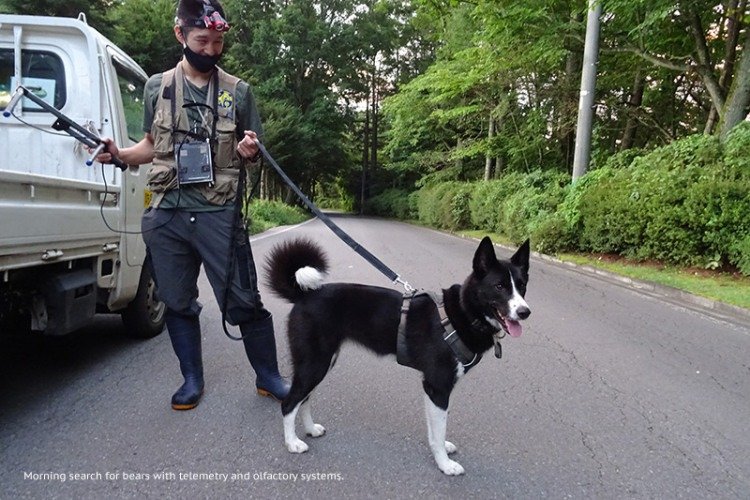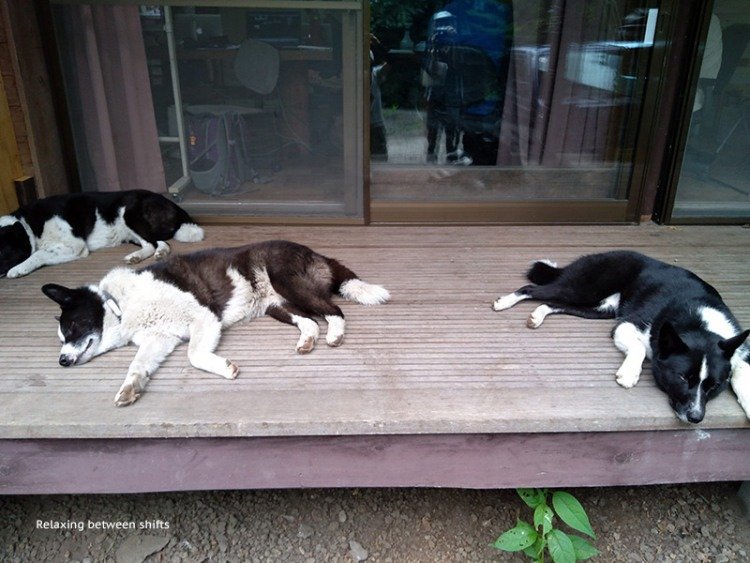Japan’s Karelian Bear Dogs help save lives, reduce injuries and educate both people and bears
 A Karelian Bear dog stretching before starting work duties
A Karelian Bear dog stretching before starting work dutiesAlthough a stressed Japanese black bear more than twice his weight and size was pounding on and clawing at the metal container, Nanuq, a Karelian Bear Dog (KBD), stood calmly. His glance moved between the bear trap and the face of his handler, Gen Oshima.
Oshima squatted next to Nanuq at one end of the barrel trap that served as a temporary cage, which we had carried to the edge of a narrow dirt road in the high mountains of Karuizawa, Nagano, Japan. It was a typical mid-summer work day for members of the Picchio bear conservation team.
Oshima hand-signaled repeatedly for Nanuq to bark. Muted woofs echoed through the lush woods and humid summer drizzle. The bear growled and crawled to the far end of the tubular enclosure. Earlier that morning, she had stepped into a painful snare trap set by a farmer hoping to catch the deer and boar who were eating his crops. After Oshima had tranquilized the bear with a dart, we examined her and moved her to a better location. Now, the bruin was fully awake … and upset.
Satisfied, Oshima told us to get inside our vehicles and close the doors. He and Nanuq scaled a slope above the trap, where they stood side-by-side. Oshima gripped a rifle loaded with rubber bullets (in case of trouble).
At Oshima’s direction, we whooped loudly, and Nanuq barked. A wildlife conservation intern sitting in a truck pulled on a rope connected to the barrel trap. As the door opened, one man shot a projectile above the trap. It exploded with a loud bang and clouds of stinky smoke. Fueled by fear, the Japanese black bear plunged outward. Using her muscular legs, she hauled herself through the thick foliage, down into a steep valley and up the other side.
To encourage the bear to move farther into uninhabited regions, Oshima and Nanuq chased after her, shouting and barking. They returned in less than 10 minutes; the bear had moved in the right direction, away from farms and residential areas. It was the 45th bear released this summer.
These releases have two objectives: freeing the bears and conditioning them to avoid people and towns. In many areas of Japan, humans do not peacefully co-exist with bears; bear sightings often provoke hostility and fear. Local government officials and hunters across Japan kill approximately 3,000 bears annually.
Saving lives, reducing injuries and educating bears about people—and people about bears—are duties of Picchio Wildlife Research Center’s bear conservation team. The human and the black-and-white, thick-furred KBD staff work hard, play hard, love each other and take naps whenever possible.

The bear team’s reputation for reducing bear/human conflicts has grown tremendously in Nagano and is spreading across Japan. In summer, local municipalities, homeowners and businesses contact Picchio almost every day. They expect the bear team to rescue bears caught in traps, to advise on methods to deter bears and to chase the bruins away. Early on, however, when Picchio started its bear-conservation efforts, many people were skeptical. Some angrily opposed the presence of bear dogs in their neighborhoods. Now, many townsfolk wave at the Picchio dogs riding shotgun in the staff trucks.
Bullet, Picchio’s first canine staff member, won the Nagano Prefectural Hometown Forestry Award in 2013—the first dog to win that award! Bullet had participated in 400 nonviolent bear hunts. Unfortunately, he passed away from leukemia the same year.
Picchio acquired Bullet from the Wind River Bear Institute (WRBI) in the U.S. One of Picchio’s bear-conflict specialists, Jumpei Tanaka, went to the U.S. to learn to work with KBDs. Today, Nanuq, Tama, Rela and Elf are following in Bullet’s large paw prints.
KBDs are the only breed Picchio and the WRBI train to shepherd bears. As WRBI Director Nils Pedersen explains, “KBD is known as one of the only breeds of dog capable of baying a grizzly bear on the ground safely and effectively. This is a genetic trait found in KBD that is very unique. Other breeds of dog are capable of treeing black bears and barking at bears, but they also tend to get hurt or killed, especially by grizzlies. The KBD is special in their ability to effectively bay a grizzly bear on the ground without getting themselves killed and without bringing the bear back on top of their handler.”
Japanese black bears (adults between 90 and 260 pounds) are much smaller and lighter than American grizzly bears, but they are still powerful animals that, in theory, could hurt a KBD (who weigh around 50 pounds). However, none of Picchio’s professional staff and agile dogs have ever been injured by bears.
KBD, who stay calm in many situations, are emotionally suited for their jobs. Though KBD show aggression toward bears when required to do so, they are friendly and affectionate with people. They’re capable of working alone or in pairs, and they always return to their handlers. Handlers and KBD work and live together, forming deep bonds.
The physical characteristics that favor their selection are strength, thick coats and tough feet for running on tough terrain in cold temperatures. Their black-and-white markings make it easier for handlers to observe their behavior when the dogs are working in low-light conditions and on snow. Tanaka believes that the KBD’s size is just right for running through the thickly vegetated local forests.
The KBD are descended from dogs that hunters along both sides of the border separating Russia and Finland have used for centuries to hunt bears and moose. They were officially recognized as a breed in 1936 by Finnish and Scandinavian kennel clubs.
Due to the success of the WRBI in training KBD to reduce conflicts and deaths, conservation organizations are now using KBD in California, Nevada, Alaska, Montana, Canada and Japan.
Picchio is the only organization in Asia using dogs for bear management, but other areas in Japan are considering following their lead. Besides being expert bear-behavior conditioners, the Picchio dogs are public-relations specialists. They join their human partners at numerous public seminars, and their warm presence, along with photographs and videos of them in the field, teach lessons about animal sentience, nonviolent wildlife management and ecological relationships.
The dogs seem to love their work, even though their shifts are irregular and they can be called to work any time a bear is sighted within or near Karuizawa.

Picchio bear specialists attach radio collars to the bears that they rescue within Karuizawa, and each night, one of the Picchio staff members uses telemetry and GPS to check on the bears’ locations. If the bears are too close to farms or homes, Elf, Tama or Nanuq, along with their human partners, are sent out early in the morning to search for those bears, which sometimes enter the farms and yards of sleeping residents. The dogs can sense the bruins, find their paths and shepherd them back into the mountains. In time, the bears learn where they can go and where they should not.
Not all KBDs are fit for bear-shepherding duties. Testing, which starts when puppies are just two months old, reveals which puppies have the capability to pass the rigorous training. Picchio uses the Volhard Puppy Aptitude Test. After Tama gave birth in 2018, WRBI Director Nils Pedersen assessed her six puppies. Only Elf and Rela passed and entered the training stage. The other four found forever homes with Picchio staff, and they often hang out at the bear team’s office, playing or napping with their hardworking family members between shifts. Nanuq, brother of Tama, is their patient uncle.
Training takes three years and is very thorough. In the first two years, the young dogs learn the basics of socialization and how to act around bears. The third year is devoted to on-the-job training, including finding bear fur that has been hidden in the woods, approaching stuffed bears, and learning both hand signals and commands given in the English language. The handlers use English commands because they want the dogs to obey them and stay on task even if Japanese people are speaking around them.
Tanaka, who created his own training techniques, uses positive reinforcement. “At the end of each day,” he says, “there must be a success.”
Most importantly, it is the mutual understanding and trust that exists between the canine and human members of the bear conservation team that leads to successes. The KBD and their people have achieved an approximately 75 percent reduction in ursine damage within commercial and residential areas, and an almost equal decrease in bear sightings. Many residents who were at first opposed the KBD program are now supporters.
Photography courtesy of Greg Goodmacher
https://thebark.com/content/bear-dogs-rescue?fbclid=IwAR1YArzIyQj8mkzocrsXALy-vqQCEAuuQ5lFk3FaZXuabULAo-IesHvutOE
No comments:
Post a Comment